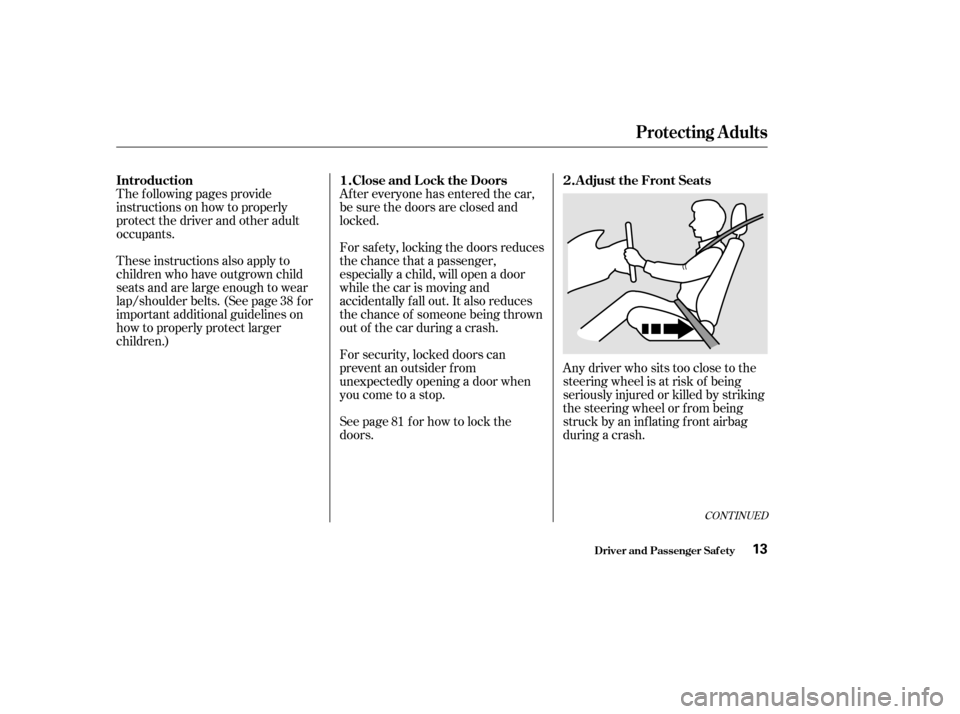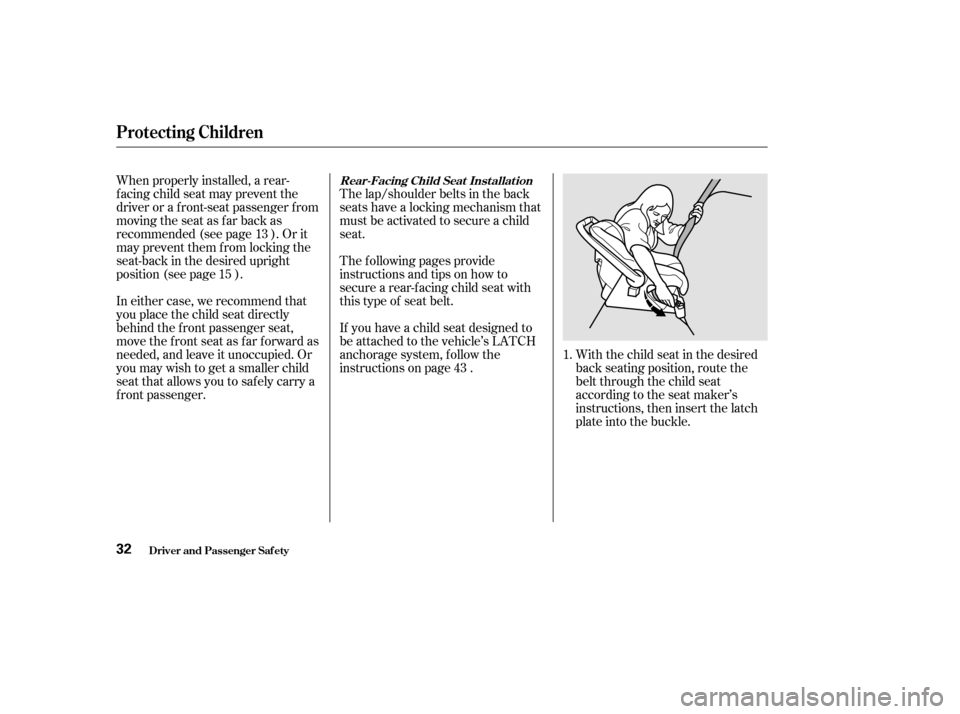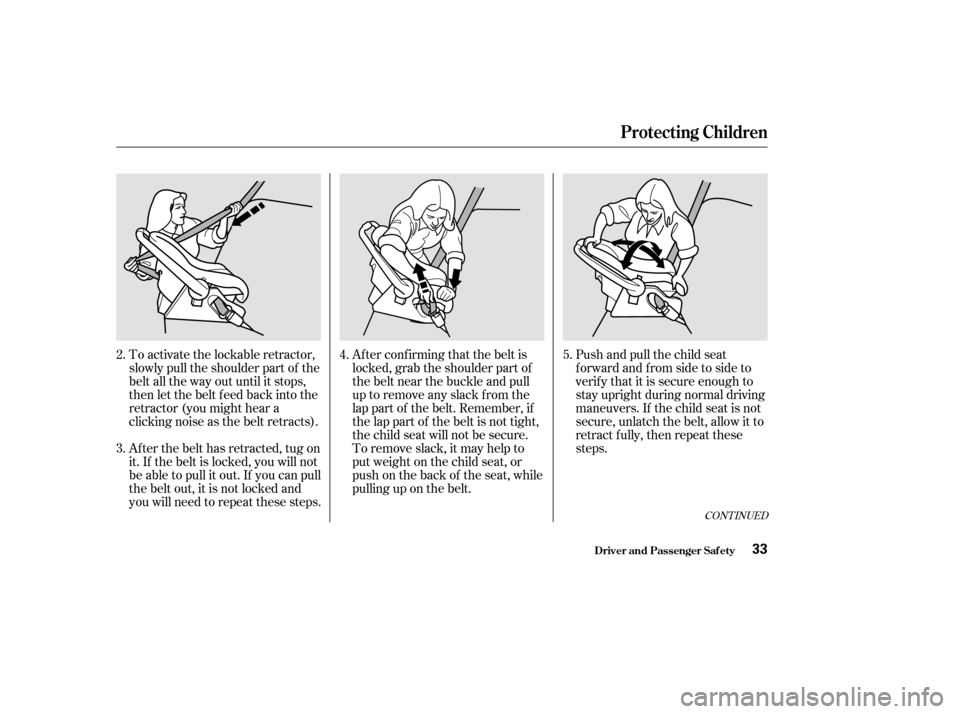2002 HONDA CIVIC lock
[x] Cancel search: lockPage 4 of 321

This section gives you important
inf ormation about how to protect
yourself and your passengers. It
shows you how to use seat belts
properly. It explains your Supple-
mental Restraint System. And it tells
you how to properly restrain inf ants
andchildreninyourcar..........
Important Safety Precautions . 6
.............
Your Car’s Saf ety Features . 7
.......................................
Seat Belts . 8
.........................................
Airbags . 10
.....................
Seats & Seat-Backs . 11
..........................
Head Restraints . 11
..................................
Door Locks . 11
........
Pre-Drive Saf ety Checklist . 12
............................
Protecting Adults . 13
.....
1. Close and Lock the Doors . 13 ...........
2. Adjust the Front Seats . 13
............
3. Adjust the Seat-Backs . 15
...
4. Adjust the Head Restraints . 16
5. Fasten and Position the Seat
.....................................
Belts . 16
....
6. Adjust the Steering Wheel . 18
7. Maintain a Proper Sitting
................................
Position . 19
.....
Advice f or Pregnant Women . 20
...
Additional Safety Precautions . 20
........................
Protecting Children . 22
All Children Must Be ...............................
Restrained . 22
Children Should Sit in the Back ...........................................
Seat . 23
The Passenger’s Front Airbag Poses Serious Risks to ...............................
Children . 23
If You Must Drive with Several ...................................
Children . 25
If a Child Requires Close ..................................
Attention . 26
...
Additional Safety Precautions . 26
General Guidelines f or Using
...............................
Child Seats . 27
.......................
Protecting Inf ants . 31 .........
Protecting Small Children . 35
.......
Protecting Larger Children . 38
Using Child Seats with
.....................................
Tethers . 42
.............................
Using LATCH . 43
Additional Inf ormation About Your .................................
Seat Belts . 45
..
Seat Belt System Components . 45
......................
Lap/Shoulder Belt . 45
Automatic Seat Belt
...............................
Tensioners . 46
...............
Seat Belt Maintenance . 47
Additional Inf ormation About ...........................
Your Airbags . 48
........................
SRS Components . 48
How Your Front Airbags
.........................................
Work . 48
...
How Your Side Airbags Work . 50
How the SRS Indicator Light
.......................................
Works . 51
How the Side Airbag Cut-of f ...........
Indicator Light Works . 52
.............................
Airbag Service . 53
...
Additional Safety Precautions . 53
.............
Carbon Monoxide Hazard . 54
...................................
Saf ety Labels . 55
Driver and Passenger Saf ety
Driver and Passenger Saf ety
5
Page 10 of 321

How you adjust your seats and seat-
backs can also affect your safety. For
example, sitting too close to the
steering wheel or dashboard
increases the risk of you or your
passenger being injured by striking
theinsideof thecar,orbyan
inf lating airbag.
Reclining a seat-back too f ar reduces
the seat belt’s ef f ectiveness and
increases the chance that the seat’s
occupant will slide under the seat
belt in a crash and be seriously
injured.Head restraints can help protect you
f rom whiplash and other injuries. For
maximum protection, the back of
your head should rest against the
center of the head restraint.
Your car’s seats are designed to keep
you in a comf ortable, upright
position so you can take f ull
advantage of the protection offered
by seat belts and the energy
absorbing materials in the seats.
Move the f ront
seats as far back as possible, and
keep adjustable seat-backs in an
upright position whenever the car is
moving. Keeping your doors locked reduces
thechanceof beingthrownoutof
the car during a crash. It also helps
prevent occupants f rom accidentally
opening a door and f alling out, and
outsiders f rom unexpectedly opening
your doors.
Seats & Seat-Backs
Head RestraintsDoor L ocks
What you should do:
Driver and Passenger Saf ety
Your Car’s Saf ety Features
11
Page 11 of 321

All adults, and children who have
outgrown child saf ety seats, are
wearing their seat belts and
wearingthemproperly(seepage).
Any inf ant or small child is
properly restrained in a child seat
inthebackseat(seepage ).
To make sure you and your
passengers get the maximum
protection f rom your car’s saf ety
f eatures, check the f ollowing each
time before you drive away:
The rest of this section gives more
detailed inf ormation about how you
can maximize your saf ety.
Remember, however, that no saf ety
system can prevent all injuries or
deaths that can occur in severe
crashes, even when seat belts are
properly worn and the airbags deploy.
All cargo is properly stored or
secured (see page ).
All doors are closed and locked
(see page ).
Head restraints are properly
adjusted (see page ).
Seat-backs are upright (see page
).
Frontseatoccupantsaresitting
upright and as f ar back as possible
f rom the steering wheel and
dashboard (see page ).
16 13
13
22 15
16
173
Pre-Drive Saf ety Checklist
Your Car’s Saf ety Features
Driver and Passenger Saf ety12
Page 12 of 321

The f ollowing pages provide
instructions on how to properly
protect the driver and other adult
occupants.
These instructions also apply to
children who have outgrown child
seats and are large enough to wear
lap/shoulder belts. (See page f or
important additional guidelines on
how to properly protect larger
children.)Any driver who sits too close to the
steering wheel is at risk of being
seriously injured or killed by striking
the steering wheel or f rom being
struck by an inflating front airbag
during a crash.
Af ter everyone has entered the car,
be sure the doors are closed and
locked.
For saf ety, locking the doors reduces
the chance that a passenger,
especially a child, will open a door
while the car is moving and
accidentally f all out. It also reduces
the chance of someone being thrown
out of the car during a crash.
For security, locked doors can
prevent an outsider f rom
unexpectedly opening a door when
you come to a stop.
See page f or how to lock the
doors.
38
81
CONT INUED
Introduction A djust the Front Seats
Close and L ock the Doors
1. 2.
Protecting Adults
Driver and Passenger Saf ety13
Page 13 of 321

See page f or how to adjust the
f ront seats.
Once your seat is adjusted correctly,
rock it back and f orth to make sure
the seat is locked in position.
Most shorter drivers can get f ar
enough away f rom the steering
wheel and still reach the pedals.
However, if you are concerned about
sitting too close, we recommend that
you investigate whether some type
of adaptive equipment may help.
To reduce the chance of injury, wear
your seat belt properly, sit upright
with your back against the seat, and
movetheseatawayfromthe
steering wheel to the f arthest
distance that allows you to maintain
f ull control of the car.
The National Highway Traffic Safety
Administration and Transport
Canada recommend that drivers
adjust the seat so the center of the
chest is at least 10 inches (25 cm)
away f rom the center of the steering
wheel.Alsomakesureyourfront
seat passenger moves the seat as f ar
to the rear as possible.
88
Protecting Adults
Driver and Passenger Saf ety14
Sitting too close to a front
airbag can result in serious
injury or death if the front
airbags inflate.
Always sit as far back from the
front airbags as possible.
Page 25 of 321

Even very young
children learn how to unlock
vehicle doors, turn on the ignition,
and open the trunk, which can
lead to accidental injury or death. Children
who play in cars can accidentally
get trapped inside the trunk.
Teach your children not to play in
or around cars. Know how to
operate the emergency trunk
opener (U.S. models only) and
decide if your children should be
shown how to use this f eature (see
page ).
Leaving children without
adult supervision is illegal in most
states and Canadian provinces,
and can be very hazardous. For
example, inf ants and small
childrenleftinavehicleonahot
day can die f rom heatstroke. And
children lef t alone with the key in the ignition can accidentally set
the vehicle in motion, possibly
injuring themselves or others.
Using this f eature will
prevent children f rom opening the
doors and accidentally f alling out
(see page ).
Using
this f eature will prevent children
f rom playing with the windows,
which could expose them to
hazards or distract the driver (see
page ).
Many parents say they pref er to put
an inf ant or small child in the f ront
passenger seat so they can watch the
child, or because the child requires
attention.
Placing a child in the f ront seat
exposes the child to hazards f rom
the passenger’s f ront airbag, and
paying close attention to a child
distracts the driver f rom the
important tasks of driving, placing
both of you at risk.
If a child requires physical attention
or f requent visual contact, we
strongly recommend that another
adult ride with the child in the back
seat. The back seat is far safer for a
child than the front.
87
86
94
Protecting Children
Driver and Passenger Saf ety
K eep car keys and remot e transmitters out of the reach ofchildren.
L ock all doors and t he t runk when
your vehicle is not in use.
Do not leave children alone in your vehicle.
Use childproof door locks t o
prevent children f rom opening t hedoors.
Use t he main power windowswit ch t o prevent children f romopening t he rear windows.
Additional Saf ety Precautions
If a Child Requires Close
Attention
26
Page 31 of 321

With the child seat in the desired
back seating position, route the
belt through the child seat
according to the seat maker’s
instructions, then insert the latch
plate into the buckle.
The lap/shoulder belts in the back
seats have a locking mechanism that
must be activated to secure a child
seat.
The f ollowing pages provide
instructions and tips on how to
secure a rear-f acing child seat with
this type of seat belt.
When properly installed, a rear-
f acing child seat may prevent the
driver or a f ront-seat passenger f rom
moving the seat as far back as
recommended (see page ). Or it
may prevent them f rom locking the
seat-back in the desired upright
position (see page ).
In either case, we recommend that
you place the child seat directly
behind the f ront passenger seat,
move the front seat as far forward as
needed, and leave it unoccupied. Or
you may wish to get a smaller child
seat that allows you to safely carry a
f ront passenger.
If you have a child seat designed to
be attached to the vehicle’s LATCH
anchorage system, follow the
instructions on page .
1.
13
15
43
Rear-Facing Child Seat Inst allat ion
Protecting Children
Driver and Passenger Saf ety32
Page 32 of 321

Push and pull the child seat
f orward and f rom side to side to
verif y that it is secure enough to
stay upright during normal driving
maneuvers. If the child seat is not
secure, unlatch the belt, allow it to
retract f ully, then repeat these
steps.
Af ter conf irming that the belt is
locked, grab the shoulder part of
the belt near the buckle and pull
up to remove any slack from the
lap part of the belt. Remember, if
the lap part of the belt is not tight,
the child seat will not be secure.
To remove slack, it may help to
putweightonthechildseat,or
push on the back of the seat, while
pulling up on the belt.
To activate the lockable retractor,
slowly pull the shoulder part of the
belt all the way out until it stops,
then let the belt f eed back into the
retractor (you might hear a
clicking noise as the belt retracts).
Af ter the belt has retracted, tug on
it. If the belt is locked, you will not
be able to pull it out. If you can pull
the belt out, it is not locked and
you will need to repeat these steps. 4.
5.
2. 3.
CONT INUED
Protecting Children
Driver and Passenger Saf ety33